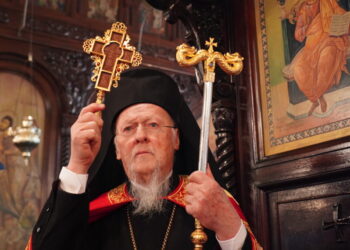On Monday, November 25, 2019, one year since the historic consecration of the Romanian People’s Salvation Cathedral was marked, the most important national project dedicated to Romania’s Great Union Centennial, a symbol of the unity of faith and of nation of Romanians.
Although the Cathedral was consecrated as ‘shell and core,’ over 150,000 Romanians came to visit it and to venerate the church altar. Pope Francis too was a pilgrim to the National Cathedral during his official visit to Romania last May. Currently, the place of worship is not open to the general public and will be under construction works for three or four years from now.

The National Cathedral will be a large church centre and a tourist attraction. Like all other great cathedrals in the world, the edifice will bring to light Romania as a state and Orthodoxy as the value of the continuation of the Romanian people, despite all the trials faced throughout history.
The Cathedral has two patronal feasts, the Ascension of the Lord (Heroes’ Day) and Saint Andrew the First-Called, Protector of Romania.
The historical event of the consecration began with the dedication of the Cathedral to all those who have sacrificed their lives for Romania’s national and spiritual unity.
During a solemn ceremony held on Saturday, November 24, 2018, the Patriarch of Romania made a gesture of liturgical and patriotic value and placed at the foot of the altar table a list containing over 350,000 names of Romanian heroes and prayed for their souls.

The consecration of the over 100 years old national desire became reality on Sunday, November 25, 2019. The ceremony was officiated by Ecumenical Patriarch Bartholomew and Patriarch Daniel.
Sixty hierarchs, thousands of clerics, many local and central authorities attended the event. A total of over 50,000 people were present, 2,000 of which inside the Cathedral.

Ecumenical Patriarch Bartholomew of Constantinople expressed his appreciation over the sacrifice and steadfastness of Romanians in carrying out this national project, about which many said it was impossible. At the same time, the Patriarch of Constantinople noted that the Cathedral was dedicated to Saint Andrew who is a patron saint of both the Ecumenical Patriarchate and the Romanian Patriarchate.
Five days after the consecration ceremony, Patriarch Theophilos III of Jerusalem came to Romania to celebrate the Divine Liturgy for the patronal feast of the National Cathedral together with Patriarch Daniel.

Due to the large number of pilgrims, the visit program initially announced to end on November 29 was extended until December 2.
After December 2, 2018, the application of mosaic iconography was resumed, the turrets were covered with copper plate and the works at the spaces outside the building, as well as at the adjacent basements, started.

This national project in which 110 million euros were invested until 2019 was carried out by the Romanian Orthodox Church in parallel with a large social work materialized in the last decade through expenses of more than 150 million euros in its more than 700 social centres.
The idea of a National Cathedral in Romania dates back to 1884, when King Carol I promulgated the Law of the Cathedral Church, a law never repealed, but which was implemented only after 126 years. The construction of the Romanian People’s Salvation Cathedral was materialized during the time of His Beatitude Patriarch Daniel, being assumed by the state as a project of national importance by law 376/2007.
Source: Basilica.ro















